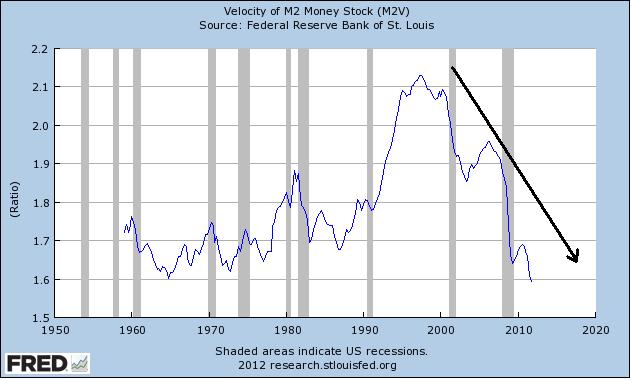Timing & trends
In order to estimate likely returns and risks in the financial markets, our general approach is to identify a set of historical instances that match current conditions on a broad range of important dimensions. In reviewing market conditions this week, what strikes me most is the pattern that emerges when we look across various horizons, from 2 weeks out to 18 months.
The chart below identifies periods in recent years where we reported market conditions as being at least “overvalued” and “overbought” in these weekly commentaries. Those two conditions alone aren’t enough, by themselves, to put the market in a “hard-negative” situation, but even those two tend to be enough to invite drawdown risk. The overvalued, overbought periods are shaded in blue on the chart below. The red lines indicate the deepest drawdown experienced by the market over the following 18 months (right scale), while the blue line charts the S&P 500 (left scale). Notably, even with weakly negative conditions – overvalued and overbought – the market has typically moved lower at some point in the next 18 months, wiping out all intervening gains. That surrender of intervening gains usually begins with a very hard and unexpected initial loss that takes out the bulk of upside progress within a period of a few days or weeks. This is a general pattern that we also see throughout market history.
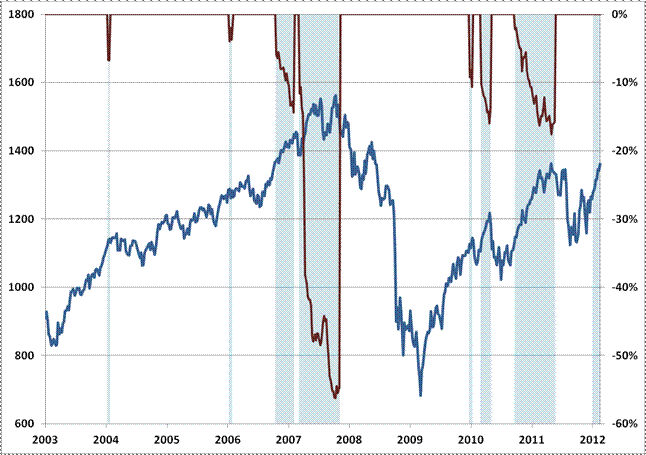
….read the entire article (its well worth reading in ful)l:


Dustan Woodhouse was one of the six Personal Finance workshop presenters at this year’s World Outlook Financial Conference. As the world markets reel from one debt disaster story to another Dustan discussed the practical realities, pitfalls and opportunities of personal debt in the days ahead.
To see Dustan’s complete PowerPoint presentation – CLICK HERE
For more information contact him at www.ourmortgageexpert.com .

Sometimes the most exciting investment opportunities fly under the radar. James Passin of Firebird Management LLC combs the world for emerging opportunities in often overlooked areas. In this exclusive interview with The Critical Metals Report, he discusses companies producing critical materials that could revolutionize defense and aviation technology and make nuclear power safer and more efficient. He also shares some commodities growth stories currently unfolding in Mongolia and East Africa.
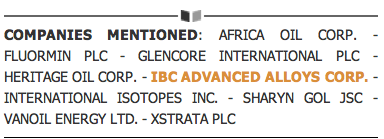
The Critical Metals Report: It’s been over two years since you last spoke with us. How have macroeconomic events affected your investment strategy?
James Passin: I am not going to discuss specific investment strategies. But it’s interesting to take a careful look at the current environment, in which there remains a huge amount of fear regarding the solvency of the world financial system. At the same time, there’s clear evidence of growth returning to the USA and certain other regions, although interest rates are near zero and central banks continue to print money. So, I see a situation in which powerful opposing forces at are work, a situation which may continue to manifest itself in violent, short-term fluctuations in asset prices.
I think that the global risk appetite is in a recovery process and that this will gradually lead to more stable capital markets, which should, generally, be positive for equity valuations. But the fear of black swans has kept a lot of cash in the sidelines. There is a danger in remaining out of the market in the current negative interest rate environment.
TCMR: What are you expecting with commodity prices in the next year or so? Will China’s growth continue, or is the country in a bubble?
JP: China has attempted to engineer what the media is calling a “soft landing,” to try to weaken real estate prices and restrain inflation. To some extent, it seems that its policies have been successful. If inflationary pressures in China continue to moderate, then the central bank should have room to loosen credit conditions. This should help to offset economic weakness.
When you look at the strength in copper, the Australian dollar and other leading or coincident indicators of Chinese economic activity, it’s very hard to take a bearish outlook on China. Major Chinese stock indexes have held at support levels and are starting to bounce. So, overall, I expect China’s economy to be somewhat constructive for commodity prices.
TCMR: Do you anticipate any significant potential disruptions to the global economy?
JP: I think we are going to see mergers and acquisitions in the commodity space following the recent high-profile merger of two very large affiliated companies, Glencore International plc (GLEN:LSE) andXstrata PLC (XTA:LSE). Companies that work closely with governments are in a position to implement strategic industrial policy, which may trigger a wave of consolidation in the commodity space and a struggle for control of a limited universe of valuable mineral assets. That environment would create a very positive scenario for the prices of mining companies’ securities in general.
TCMR: Would you say the giant majors and governments of developing nations are competing for assets at the lower end of the food chain?
JP: There’s a lot of evidence to support this view. Indian companies now seem to be on the hunt and there are a lot of buyers for world-class resources. A number of companies that control world-class resource projects seem to have very compelling valuations, following the horrendous equity market in fourth quarter of 2011. I suspect we are going to see a huge number of merger deals, hostile takeovers and various forms of consolidation, reducing the supply of commodity shares.
TCMR: You are invested in critical and strategic metals. What looks attractive to you in those investment areas?
JP: One area we’re focused on is fluorspar, which is an important mineral used in a number of metallurgical processes, such as aluminum production. It’s also the raw material necessary for the production of hydrofluoric acid, which is the precursor to all hydrofluoric chemicals and a number of products containing fluorine or made through the process of fluorination. It’s an obscure commodity, but it is critical to modern life and to the world economy. In fact, it’s so strategic that the EU put it on the list of critical commodities. There has been a lot of government angst about the availability of fluorspar because China controls approximately 50% of world fluorspar production. China was once a fluorspar exporter, but the country is moving more toward exporting value-added chemicals and consuming the raw chemicals itself. That means the rest of the world has to look for non-Chinese sources for fluorspar. There are very few sources of fluorspar from operating mines and not many deposits can be brought into production in the near future either.
TCMR: What are some companies focusing on fluorspar production?
JP: I would suggest taking a look at Fluormin Plc (FLOR:AIM), listed on the AIM Market of the London Stock Exchange. Fluormin owns the producing Witkop fluorspar mine in South Africa as well as 20% of a producing Kenyan fluorspar company. It has other fluorspar exploration projects in various African countries and a joint venture with a fluorspar trading company. Fluormin is a significant producer and trader in the global fluorspar industry. The company is controlled by Firebird and I serve with another colleague on the board of directors.
TCMR: Last time we met, you discussed IBC Advanced Alloys Corp. (IB:TSX.V; AALF:OTCQX). What’s going on with that company?
JP: The stock has been somewhat stagnant, but IBC Advanced Alloys has been growing its revenue. We’re intrigued by the company’s Beralcast business, which involves an aluminum-beryllium composite material with unique characteristics that make it attractive in defense aviation platforms and, potentially, in various commercial aviation applications. It could be a game-changer when you look at the market for beryllium-aluminum composite materials. The company is also exploring for beryllium in Utah, with some promising recent results. I should note that IBC was co-founded by Firebird and Firebird remains a significant shareholder in the company.
TCMR: You cover a wide range of investment arenas both geographically and in terms of commodity type. What looks promising in the energy arena?
JP: Since we started following East African oil in 2003, there have been a number of very large, important discoveries, the most famous of which was Heritage Oil Corp. (HOC:TSX; HOIL:LSE) discovery in Uganda, which proved the existence of world-class oil basins in the Great Rift Valley, precipitating a wave of strategic interest in East Africa. At the same time, evolving geopolitical dynamics are now supportive to East African oil development. For example, South Sudan’s independence created momentum for a new pipeline that can potentially link offshore East African oil fields to export markets, creating a platform for monetization of otherwise stranded oil deposits.
TCMR: What companies in this space are you considering?
JP: I am the Chairman and Interim CEO of Vanoil Energy Ltd. (VEL:TSX.V), which has two blocks in Kenya. Given the amount of interest in Kenya now and the number of deals that we can point to in East Africa, I think it’s worth considering independent companies with acreage in Kenya and the surrounding countries. Vanoil has had some encouraging results from its seismic program and we look forward to advancing further work on our Kenyan properties under the terms of our Production Sharing Contracts. Firebird’s East African holdings include Africa Oil Corp. (AOI:TSX.V), a Lundin company. It has a number of interesting oil exploration projects in East Africa, and the company is currently drilling on two properties, one in Kenya and one in the Puntland Province of Somalia. I’ve been to the Somalian oil concession—it has the potential to prove the existence of Yemen-size oil basins in the Horn of East Africa.
TCMR: You also mentioned Mongolian coal. What’s going on there?
JP: Mongolia has a host of remnants of the sea that vanished when the Indian and Asian subcontinents collided a long time ago. Those remnants formed a vast sedimentary basin that has been transformed into one of the world’s largest undeveloped coal provinces, with both thermal and coking coal. Mongolia’s thermal coal story is quite interesting. China is now the world’s largest importer of thermal coal, while India has very limited supplies of thermal coal. Mongolia will inevitably emerge, in my view, as an important regional thermal coal supplier.
Also, Mongolia is the world’s fastest-growing economy. This is creating a growing need for new electricity generation capacity. The country’s large thermal coal deposits have an important role to play in providing domestic energy. There’s a wave of new interest in Mongolia from strategic and financial investors. We think that the country’s real 2011 gross domestic product (GDP) is probably going to end up 18% higher than the prior year. We believe this GDP is going to keep compounding at a very high rate over the next 10–20 years.
TCMR: How can investors participate in the market in Mongolia? There is a stock exchange there, but not many companies, and liquidity is low. What’s the story there?
JP: We’re very active investors in the Mongolian Stock Exchange (MSE). Certainly the market is not liquid, but there are no restrictions on foreign ownership of shares, and the currency is freely exchangeable. It is very easy to open and fund a brokerage account. The hard part is sourcing shares. The London Stock Exchange (LSE) is now managing the MSE under a three-year contract. We’re quite optimistic about the potential for liquidity on the MSE to increase in the future. Some thermal coal stocks are listed on the MSE, such as Sharyn Gol JSC (SHG:MSE), a coal producer controlled by Firebird. There are other coal companies with assets in Mongolia that are listed on other major exchanges, although we don’t have a particular view on those companies.
TCMR: Let’s switch to nuclear. The U.S. Nuclear Regulatory Commission (NRC) granted some licenses in the last few weeks—the first ones in nearly 35 years. What effect is that going to have on the nuclear fuels and related industries and equipment suppliers?
JP: Although I’ve generally reduced my focus on the nuclear industry following our broad exit from the space during the uranium bubble in 2006, we remain long-term bulls on nuclear power. It is the only economic means of producing electricity without producing vast amounts of carbon. Many government policies will most likely continue to provide at least some economic inducement for nuclear power generation. China will continue to build new nuclear reactors irrespective of the changing political sentiment in some countries following the Fukushima disaster. My focus is mainly in companies that are providing essential services to the nuclear industry and are positioned to benefit from the continued long-term growth in nuclear power generation capacity.
TCMR: What service companies appeal to you?
JP: A U.S. company, International Isotopes Inc. (INIS:OTCBB), is seeking a Nuclear Regulatory Commission (NRC) permit to build the first and only uranium de-conversion and fluorine extraction plant in the world. This plant will take depleted uranium hexafluoride, the toxic waste byproduct of uranium enrichment, and convert it into a stable form of depleted uranium, while extracting the commercially valuable fluorine content. The resulting waste material is far safer and cheaper to store and transport than depleted uranium hexafluoride. If this plant is financed and built and operates successfully, it should significantly reduce the environmental impact of the nuclear fuel cycle.
TCMR: How much commercial value is there in the fluorine? Will the company see substantial profits from producing safer uranium?
JP: I expect the company to have two major revenue streams. The first would be the payment it receives for de-converting uranium hexafluoride, as this provides a direct benefit to the producers of depleted uranium hexafluoride. The second revenue stream will come from extracting the fluorine content and producing fluorine gases and other fluorine products, which it can sell commercially.
TCMR: How large is the fluorine gas market and what kind of sales could International Isotopes expect?
JP: I don’t want to get into financial projections, but the fluorine market is quite large. If you look at all of the fluoride chemical products, especially fluorine gases and products made through the process of fluorination, it is an immense market. I would note that Firebird is a significant shareholder in International Isotopes.
TCMR: We appreciate your time and thoughts today.
JP: My pleasure.
James Passin joined Firebird in 1999. James is a graduate of St. John’s College, where he majored in philosophy and classical literature. James serves on the board of directors of several Mongolian and Canadian companies, including Sharyn Gol JSC, Baganuur JSC, BDSec JSC, National Investment Bank of Mongolia, Vanoil Energy Ltd., Undur Tolgoi Minerals Inc. and Fluormin PLC, a UK fluorspar mining company.
Want to read more exclusive Critical Metals Report articles like this? Sign up for our free e-newsletter, and you’ll learn when new articles have been published. To see a list of recent interviews with industry analysts and commentators and learn more about critical metals companies, visit our Critical Metals Report page.
DISCLOSURE:
1) Zig Lambo of The Critical Metals Report conducted this interview. He personally and/or his family own shares of the following companies mentioned in this interview: None.
2) The following companies mentioned in the interview are sponsors of The Critical Metals Report: IBC Advanced Alloy Corporation. Streetwise Reports does not accept stock in exchange for services.
3) James Passin: I personally and/or my family own shares of the following the following companies, either directly or through indirect ownership through funds and related business entities, mentioned in this interview: Vanoil Energy, Ltd., Fluormin PLC, Sharyn Gol JSC, International Isotopes Inc., IBC Advanced Alloy Corporation and Africa Oil Inc. I personally and/or my family am paid by the following companies mentioned in this interview: none. I was not paid by Streetwise for participating in this story.

“So what?” he asked. “Things will only get worse. We have reached a point where we’re trying to figure out how to survive just the next day, let alone the next 10 days, the next month, the next year.”
-Anastasis Chrisopoulos, Athens taxi driver (from Reuters)
130-billion-euro here, 130-billion-euro there, and pretty soon you have to start finding some growth!
One adage that seems to work as much as anything else, and why it is an adage I guess, is “buy the rumor and sell the news.” I won’t bore you with the behavioral aspects of why this works, I think you know. We are seeing it a bit this morning on display on news a Greek default has been averted: the euro is lower, and ditto for most Eurozone bonds since the announcement of a deal that gives Greece another 130-billion-euro it can pour down the rabbit hole with the rest of the money funneled in by Eurozone taxpayers.
Of course, sooner or later financial engineering reaches the limits of its public relations effect and there must be some underlying payoff from said engineering besides getting funds to follow banks chasing into periphery debt for a trade. It’s not that rising periphery bond prices, i.e. lower yields, isn’t helpful; it is. But even at current rate levels, it will be mighty hard for many countries to maintain austerity pledges; all attempts to do so will likely accentuate the trend we see in the chart below:
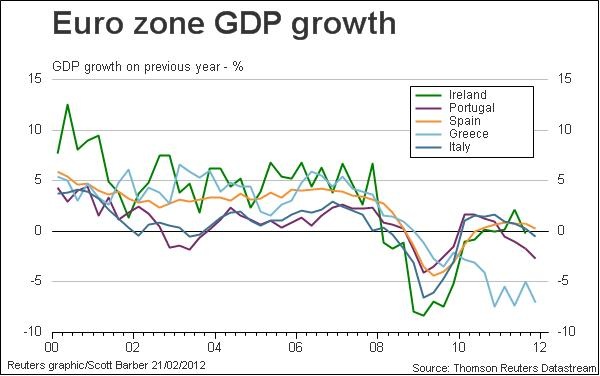
And of course, this chart is the mirror image of the domestic adjustments periphery countries have to make because they do not have a free-floating currency available to help them make these adjustments:
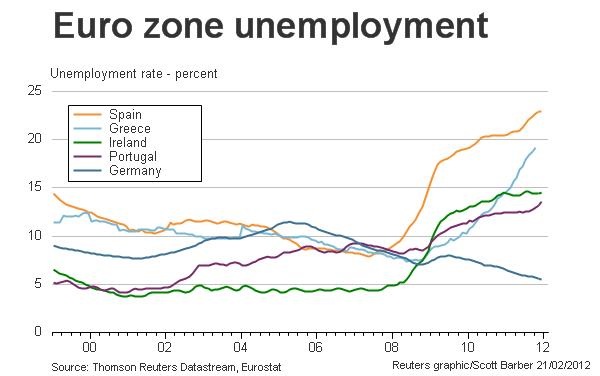
Thus, periphery economies desperately need some growth. Rising unemployment and tighter budgets will not produce revenues needed to pay debt; instead it produces a self-feeing vicious spiral downward. This view seems completely at odds with the Troika program even though the Greek economy provides them with live test case of abject failure stemming directly from the implementation of their own flawed theories.
And here is why it will likely get worse for Greece and other periphery countries whose growth is heading lower—the real economy will be starved.
We have already witnessed this economic/money/manipulation phenomenon in the US, from the WSJ this morning:
“The eight giant European banks that have disclosed their annual results in recent weeks reported holding a total of about $816 billion in cash and deposits at central banks as of Dec. 31. That is up 50% from a year earlier, when the same banks were holding roughly $543 billion.”
Does any of this sound familiar? You can lead a horse to water, in fact you can force-feed said horse with massive amounts of reserves, but you can’t make him lend any of it to the real economy where real people build real businesses and hire other real people who need real jobs.
Just in case you forgot just how tightly US banks have held on to their Fed sponsored reserves via the massively steep yield curve that impoverishes savers to subsidize bank healing, here is a look. This chart shows reserves in the US banking system … hmmm … three years and counting so far since Bernanke and Company decided this is the only viable strategy for the economy. Viable for financial assets, but the other side of the economy is still starved …

The point is, despite the new Greek rescue (I am losing count how many we have had so far), it appears the Eurozone, now clearly a two-track world with Germany bathing in credit and low rates and low unemployment (which adds to more angst and animosity toward Germans amongst the PIIGS), appears collectively heading into deeper recession.
One wonders if now, finally, EU leaders have run out of rabbits of financial engineering to pull from their hats. Financial engineering is a lot easier than real growth. If you don’t believe me, go ask Goldman; after all it is their fun and games that caused much of this Greek problem in the first place.
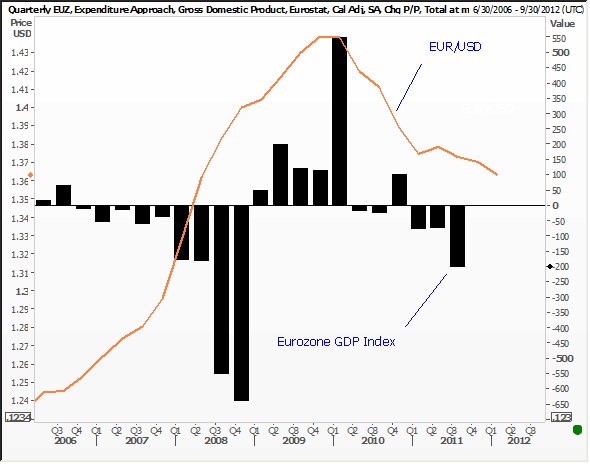
Hmmm …






